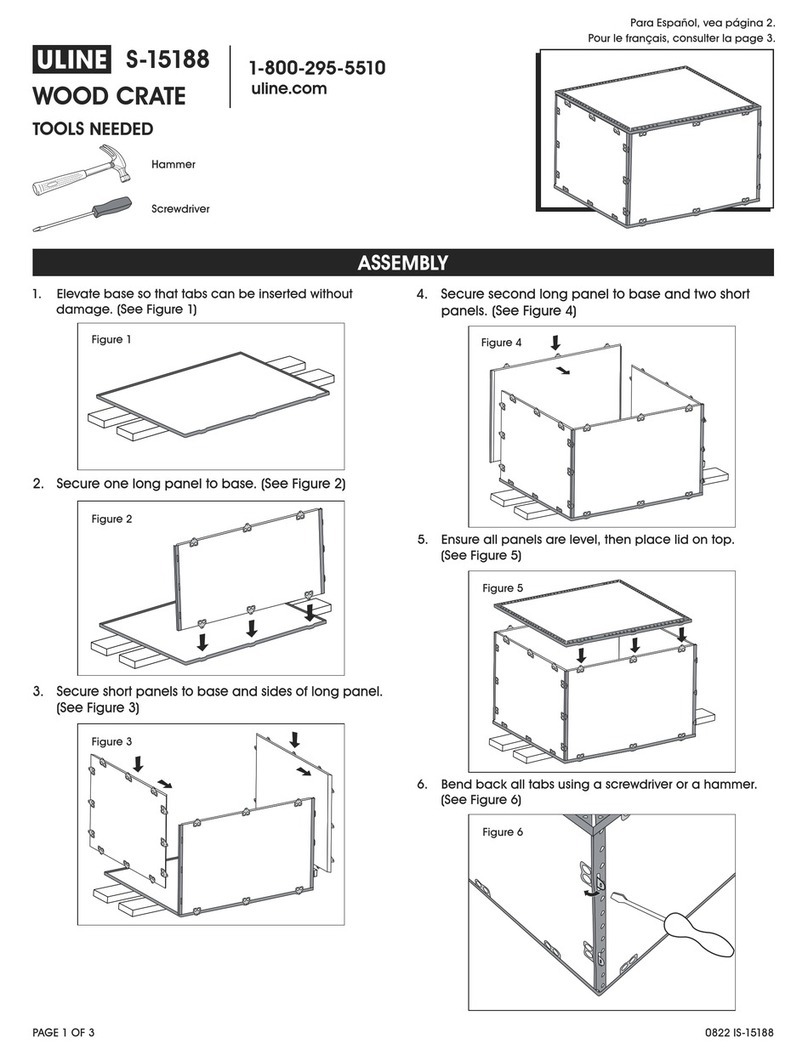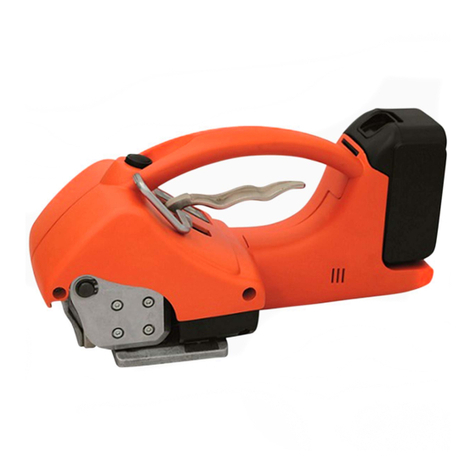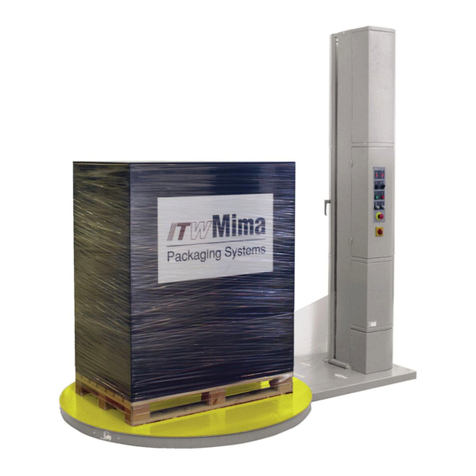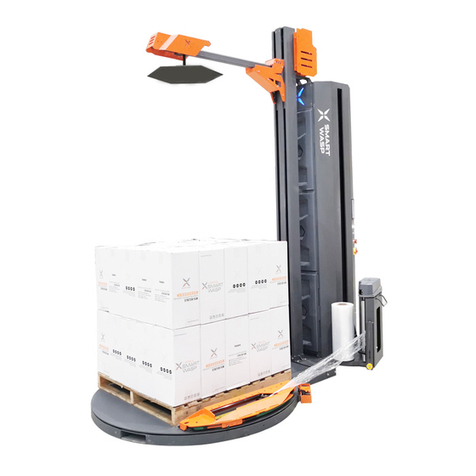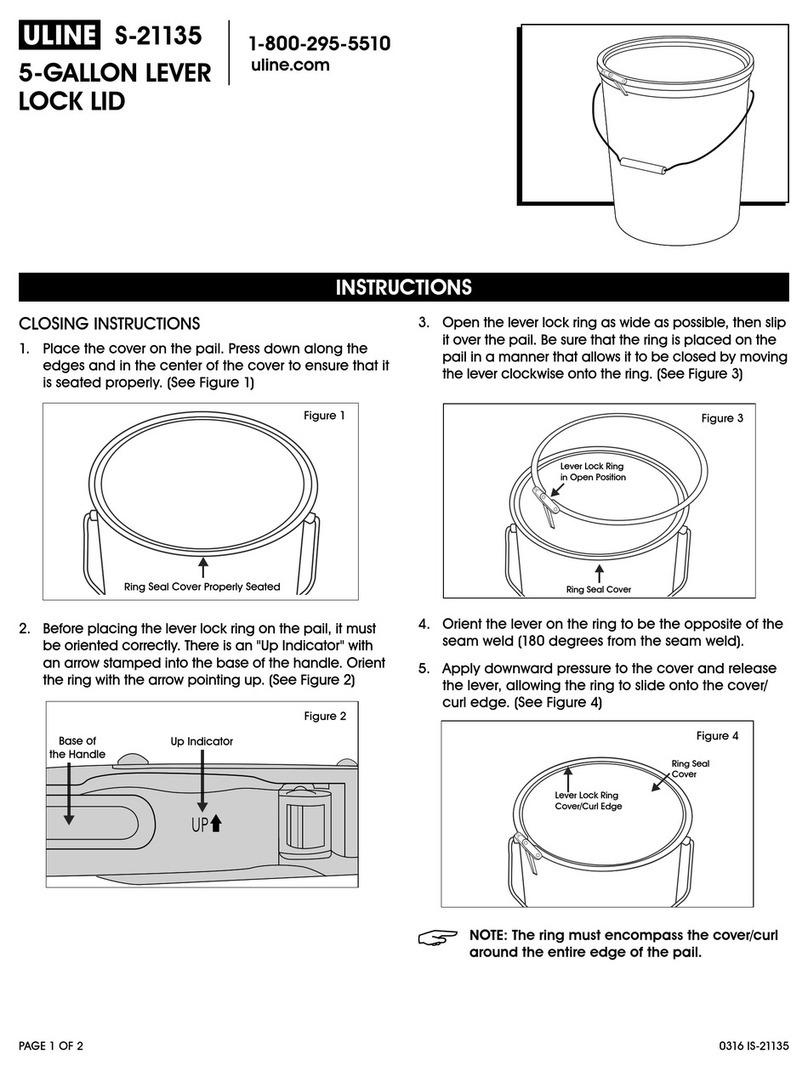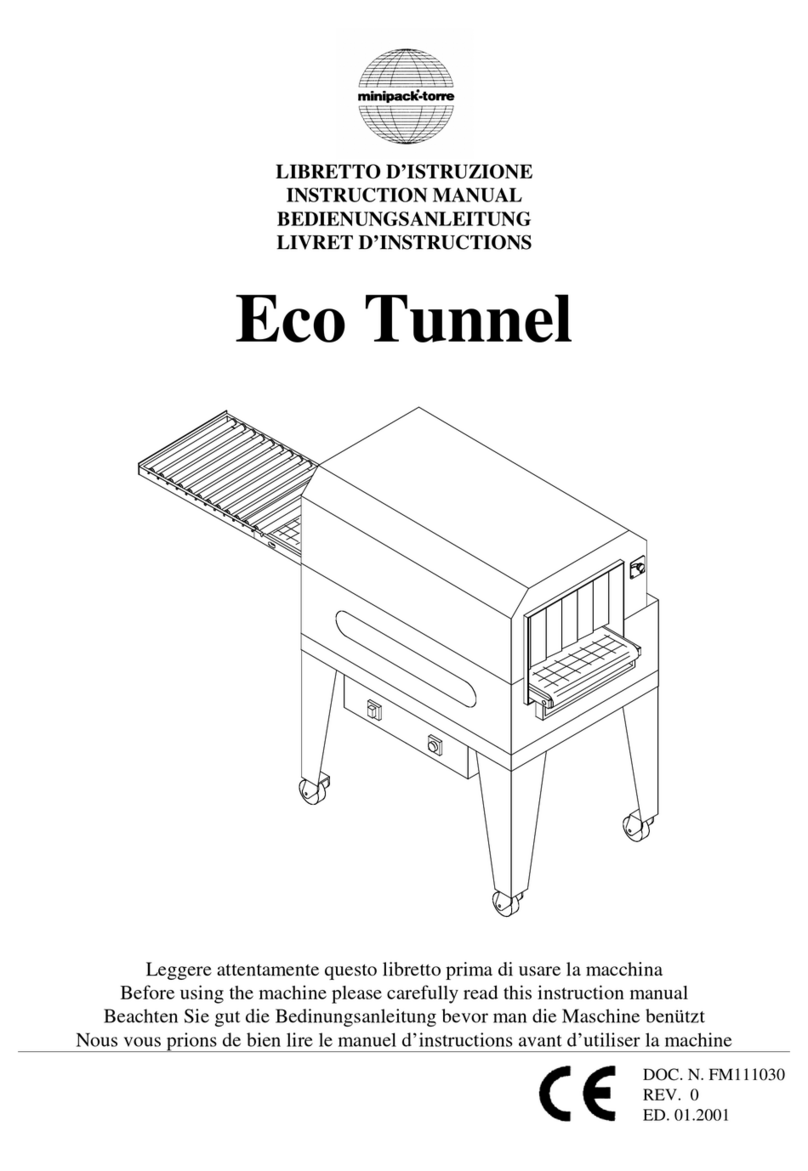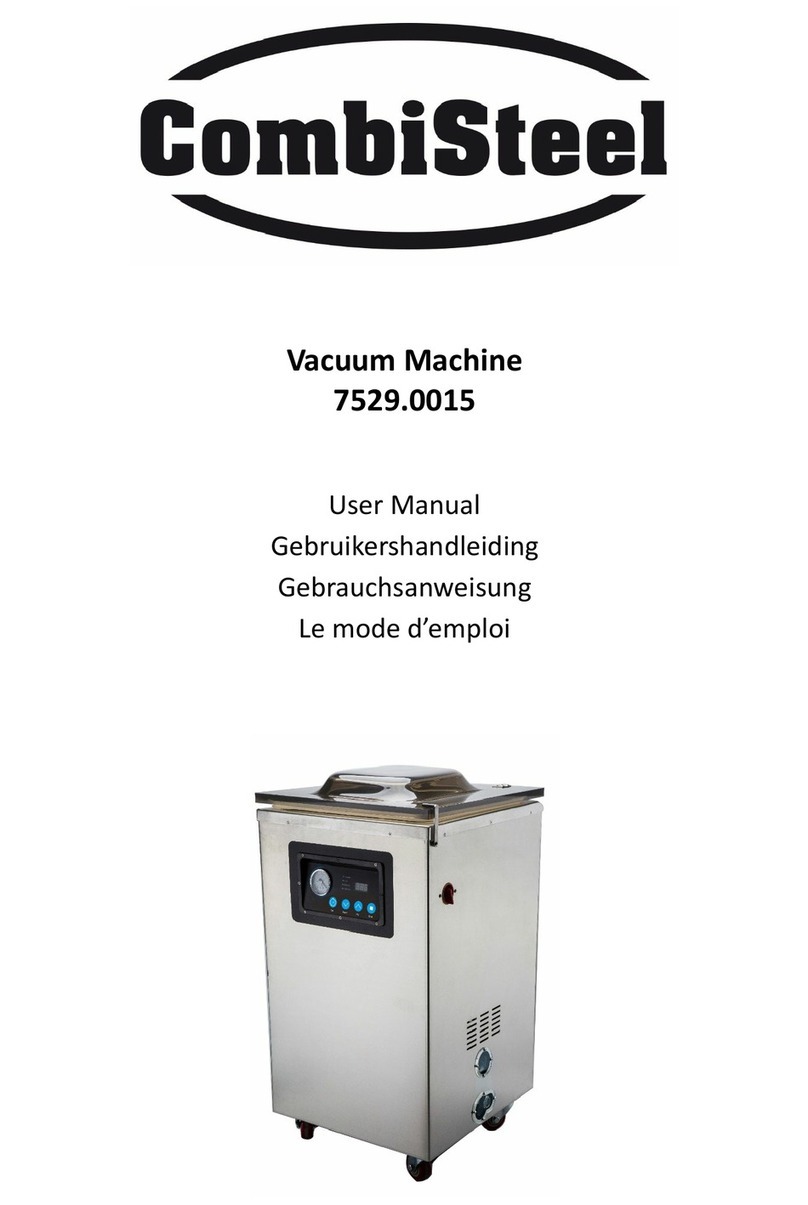GrainPro Gas-Hermetic Fumigation Self Verifying... User manual

GRAINPRO®GAS-HERMETIC FUMIGATION
SELF-VERIFYING COCOON™
INSTRUCTION MANUAL
MA2021TDB1199-19

2/24
GrainPro®Gas-Hermetic Fumigation/Self-Verifying Cocoon™ Instruction Manual
MA2021TDB1199-19
GrainPro Inc.
4410A Connecticut Avenue. NW, #163, Washington, DC 20008
Tel : +1 202-921-6700
Email : sales@grainpro.com
GrainPro®Philippines, Inc.
Lot 46 Efficiency Avenue, Subic Bay Gateway Park I, Subic Bay Freeport Zone 2222
Philippines
Phone: +63 47 252 7884 Fax: +63 47 252 7885 Website: www.grainpro.com
Email: salesasia@grainpro.com
GrainPro Kenya
Space Apartments, GF Shio A2 Maimahui Rd. Nairobi West, Kenya
Tel: +254 737 177 767
Fax: +254 710 933 717
Email: sales@grainpro.com
GrainPro Mexico, S de RL de CV
Ctoo. Garona No. 903, Sección Tres, Col. Amberes, 37237,
León, Gto. Mexico
Mobile: +52 1 (477) 392 0851
Email: guillermo@grainpro.com
GrainPro Costa Rica S.R.L.
Residencial Valle del Sol, Calle Lajas, Casa #27 Alto de las Palomas,
Santa Ana, San José, Costa Rica
Tel: +506 2282 9129
Email: infogpcr@grainpro.com
GrainPro India Post-Harvest Technology Pvt. Ltd.
Office Number 18A109, WeWork Berger Tower 18th Floor,
C-001/A2, Sector 16-B, Noida, INDIA –201301
Landline: +91 120 515 0017
Customer Service: +91 960 292 0202
GrainPro®Inc., 1401 K Street NW, Suite 502, Washington D.C. 20005 USA
Copyright 2019 GrainPro®, Inc.

3/24
GrainPro®Gas-Hermetic Fumigation/Self-Verifying Cocoon™ Instruction Manual
MA2021TDB1199-19
TABLE OF CONTENTS
1. INTRODUCTION........................................................................................................................4
2. CHECKLIST...............................................................................................................................5
3. COMPONENTS ........................................................................................................................6
4. SPECIFICATIONS .....................................................................................................................7
Materials ...............................................................................................................................7
Products................................................................................................................................7
5. INSTALLATION..........................................................................................................................8
Site selection.........................................................................................................................8
Loading .................................................................................................................................8
Positioning the top section....................................................................................................9
Use of Desiccant (Calcium Chloride, CaCl2)- (Recommended) ..............................................10
Zipping ................................................................................................................................10
Pressure DecayTest (PDT).................................................................................................12
Use of Security Tape - (Optional) .......................................................................................13
Tensioning of straps............................................................................................................13
Procedure for purging carbon dioxide (CO2)......................................................................13
Monitoring the oxygen level and Relative Humidity (RH%)................................................16
Dismantling ........................................................................................................................17
6. PREVENTING CONDENSATION............................................................................................18
Why does condensation occur?..........................................................................................18
Moisture Content (MC) requirement for safe storage.........................................................18
Setting-up the GrainShade (Outdoor Installation) ..............................................................18
7. MAINTENANCE AND CARE ...................................................................................................18
Regular examination...........................................................................................................18
Physical inspection .............................................................................................................19
Repairing punctures and other damages............................................................................20
Prohibited items not allowed to ship ...................................................................................20
Cleaning top and bottom sections ......................................................................................20
Folding ................................................................................................................................20
Safekeeping........................................................................................................................21
Platform installation of rodent guard (RG)..........................................................................21
Termite control....................................................................................................................21
Recycling ............................................................................................................................22
8. FREQUENTLY ASKED QUESTIONS AND ANSWERS .........................................................22
9. WARRANTY CLAUSE.............................................................................................................24

4/24
GrainPro®Gas-Hermetic Fumigation/Self-Verifying Cocoon™ Instruction Manual
MA2021TDB1199-19
1. INTRODUCTION
The GrainPro®Gas-Hermetic Fumigation Self Verifying CocoonTM (G-HF SVC) is a flood
protected, Ultra Hermetic™ gas-tight storage designed for insecticide-free fumigation specifically CO2
fumigation to immediately control any infestation and safe storage of durable agricultural commodities.
G-HF SVCTM are either standard size or custom-made to enclose stacks of boxed, crated, or bagged
agricultural commodities. It is made of flexible UV-resistant Polyvinyl Chloride that is resistant to rodents
and has low permeability to oxygen (O2), and moisture. Includes one transparent plug to monitor the
relative humidity (RH) inside.
G-HF SVC able to withstand floods below zipper line and can maintain the gas resulting from
the respiration of insects and commodity; low oxygen and high carbon dioxide levels will control
infestation and mold growth.
1.1. FEATURES AND ADVANTAGES:
1.1.1. Preserves the quality of the stored commodities.
1.1.2. Moisture level of the commodity remains constant.
1.1.3. The commodity can be stored at ambient temperature instead of using energy consuming cold
storage methods where sub-zero temperatures are required to prevent insect infestation and bio-
chemical deterioration.
1.1.4. Installation demands little infrastructure.
1.1.5. Weather-resistant and UV-protected (could be used indoors or outdoors).
1.1.6. Inhibits aflatoxin growth and suffocates pests and insects.
1.1.7. Allows users to check oxygen and relative humidity levels.
1.1.8. Easy to maintain and repair.
1.1.9. “Green” fumigation technology, acknowledged as organic fumigation using CO2.
1.2. PRODUCT GUARANTEE:
1.2.1. In accordance with the terms and conditions herewith, GrainPro, Inc. guarantees the quality of
this product per its written warranty provided it is used according to the instructions in this manual.
1.2.2. Please read and understand the manual thoroughly before using the G-HF Cocoon.
1.3. COMMENTS, COMPLAINTS, AND/OR CLARIFICATIONS:
1.3.1. Please contact customercare@grainpro.com.
1.3.2. We shall be glad to address any of your concerns.

5/24
GrainPro®Gas-Hermetic Fumigation/Self-Verifying Cocoon™ Instruction Manual
MA2021TDB1199-19
2. CHECKLIST
Please inspect your GrainPro G-HF/S-VC Cocoon to ensure that the package includes the
following items:
PART NAME
DESCRIPTION
IMAGE
2.1. CARRY BAG
2.1.1. Contents:
a. G-HF Cocoon
(Top and Bottom)
b. GrainShade™
c. Small parts
d. Repair kit
e. Instruction manual
2.2. ZIPPER PULL
2.2.1. For zipper sealing
2.2.2. One (1) set (left and
right)
2.3. PATCHING
MATERIAL
2.3.1. White-colored PVC
roll for patching
holes and other
damages
(30cmx1.5m).
2.3.2. One (1) piece
2.4. GLUE
2.4.1. For patching PVC
materials.
2.4.2. One (1) tube
2.5. SILICON SPRAY
2.5.1. For zipper lubrication.
2.5.2. One (1) can (for 5-
150MT)
2.5.3. Two (2) cans (for
300MT and above)

6/24
GrainPro®Gas-Hermetic Fumigation/Self-Verifying Cocoon™ Instruction Manual
MA2021TDB1199-19
2.6. TAPE MEASURE
2.6.1. For checking the
height of the stack.
2.6.2. One (1) piece
2.7. GRAINSHADE™
2.7.1. Reflective cover
material for outdoor
installation.
2.7.2. (One) 1 piece
2.8. EXTRA ROPE
2.8.1. For tying the
GrainShade™.
2.8.2. Ten (10) meters long
(min.)
2.9. RODENT
GUARD
2.9.1. For platform post to
prevent rodent
access when storing
the empty G-HF
Cocoon.
2.9.2. Four (4) pieces per
pack
2.10. INSTRUCTION
MANUAL
2.10.1 Installation
instructions.
2.10.2 Maintenance
instructions.
2.10.3 Frequently asked
questions and
answers.
2.10.4 Warranty clause.

7/24
GrainPro®Gas-Hermetic Fumigation/Self-Verifying Cocoon™ Instruction Manual
MA2021TDB1199-19
3. COMPONENTS
4. SPECIFICATIONS
4.1. MATERIALS
PARAMETERS
STANDARD
Material
Polyvinyl Chloride
Color
White
Thickness, cm (inch)
0.083(0.033)±7%
Material Weight, g/m2
1,050
OTR (Oxygen Transmission Rate), cc/m2/day
<500
WVTR (Water Vapor Transmission Rate), g/m2/day
<9
Sealing mechanism
PVC Hermetic Zipper
Shelf Life, years
10
Warranty, years
5
4.2. PRODUCTS
G-HF COCOON
CAPACITY
(MT)*
LENGTH
cm (inch)
WIDTH
cm (inch)
HEIGHT
cm (inch)
VOLUME
m3
GP G-HF Cocoon-005
5
297.5
(117.13)
165.0
(64.96)
150.0
(59.06)
7.36
GP G-HF Cocoon-010
10
330.0
(129.92)
297.5
(117.13)
150.0
(59.06)
14.73
GP G-HF Cocoon-020
20
398.0
(156.69)
380.0
(149.61)
200.0
(78.74)
30.25
GP G-HF Cocoon-2-050
50
890.0
(350.39)
440.0
(173.23)
200.0
(78.74)
78.32
GP G-HF Cocoon-3-050
50
595.0
(234.25)
435.0
(171.26)
300.0
(118.11)
77.65
GP G-HF Cocoon-100
100
860.0
(338.58)
580.0
(228.35)
300.0
(118.11)
149.64
GP G-HF Cocoon-3-150
150
890.0
(350.39)
850.0
(334.65)
300.0
(118.11)
226.95
GPG-HF Cocoon-4.5-150
150
750.0
(295.28)
680.0
(267.72)
450.0
(177.17)
229.50
GP G-HF Cocoon-300
300
926.0
(364.57)
745.0
(293.31)
597.5
(235.24)
413.92
*Based on bulk density of wheat

8/24
GrainPro®Gas-Hermetic Fumigation/Self-Verifying Cocoon™ Instruction Manual
MA2021TDB1199-19
5. INSTALLATION
5.1. SITE SELECTION
5.1.1. In selecting a site, look for:
a. G-HF Cocoon is designed for both
indoor and outdoor installations.
b. A smooth area away from standing or
running water.
c. Ensure that the site is protected from
stray animals and from theft.
d. Shade (otherwise under a
GrainShade™) to minimize
temperature differences.
5.1.2. Prepare the selected site by clearing away all sharp objects (stones, broken glass, nails, etc.)
that may puncture the G-HF Cocoon. Sufficient space to accommodate the G-HF Cocoon and
an inspection path around (at least 50 cm each side).
5.1.3. If ground will be used as flooring, put a
layer (5cm) of fine sand (or any equivalent)
on top of the soil as ground foundation.
5.1.4. During loading, make sure that workers do not wear shoes with spikes that may damage the
G-HF Cocoon. Preferably, choose a site that offers ease in loading/unloading, away from
crowded areas and rubbish. For indoor installation, clean the area to remove sharp objects.
5.2. LOADING
5.2.1. Check the moisture content of the
commodity to ensure the MC is at a safe
level.
5.2.2. Loading the bottom section:
a. Unfold the bottom section of the
Cocoon and lay it out on the prepared
site.
b. Start piling the sacks on the bottom
section.
c. Put down the first four bags each in
every corner of the G-HF Cocoon.
d. Make sure that the bottom section is
stretched by pulling the corners with
the bags. Stretching will reduce the risk
of rodent damage.

9/24
GrainPro®Gas-Hermetic Fumigation/Self-Verifying Cocoon™ Instruction Manual
MA2021TDB1199-19
5.2.3. Required stack height:
a. Load the first layer of sacks in one
direction.
b. Continue adding layers in an
interlocking manner (crisscross), i.e.
one layer on the top of the previous
layer.
c. Stacked sacks to the corresponding
height.
5.2.4. Providing a cavity/canal for CO2flushing:
a. Create a cavity/canal about 1-2 layers
(20cm wide-up) aligned with the inlet
port to the center of the stack.
b. This will help facilitate CO2flushing and
avoid dry ice build-up that may cause
the G-HF Cocoon liner becomes brittle
that will eventually crack/explode.
5.2.5. Mechanical loading of bagged commodity (optional for larger G-HF Cocoon):
a. Stacking of grains involves diverse equipment such as conveyor, forklift or crane.
b. Operations provide continuous stacking without delays especially for outdoor installation.
Conveyor
Forklift
Crane
5.2.6. The top layer:
a. Continue piling the sacks until the
desired G-HF Cocoon height is
reached.
b. Once you have reached the required
stacking height, provide one line of
sacks in the middle along the longitude
of the stack.
c. This creates a crest that will keep
rainwater from accumulating on the top
of the G-HF Cocoon.
5.3. POSITIONING THE TOP SECTION
5.3.1. There are several ways to place the top section:
a. By rolling.
b. By using forklift or conveyor.
Rolling method
Use of forklift
Use of conveyor
5.3.2. Unfold the top section over the stack, making sure that top and bottom section arrows are
aligned and tension straps are outside.

10/24
GrainPro®Gas-Hermetic Fumigation/Self-Verifying Cocoon™ Instruction Manual
MA2021TDB1199-19
5.3.3. One pair of arrows is painted green. Match these arrows for correct front and back orientation
of the Cocoon.
5.3.4. Pull the sides all the way down over the stack.
5.3.5. Do not use tensions straps to pull or carry the top section.
5.4. USE OF DESICCANT (CALCIUM CHLORIDE, CaCl2) –(Recommended)
5.4.1. Required dosage of Calcium Chloride, CalCl2.
5.4.2. Place the packed desiccant (Calcium Chloride, CaCl2), at the middle-top portion of the
bags inside the SVC G-HF before Zipping.
5.4.3. If it will be in six(6) months of storage, spread-out the packed desiccant (Calcium Chloride,
CaCl2) at the top portion of the bags inside the SVC G-HF before Zipping.
G-HF COCOON
CAPACITY
Desiccant Require (CaCl2)
for 1month of Storage
Desiccant Required (CaCl2)
for 6months of Storage
(MT)
grams
grams
GP G-HF Cocoon-005
5
50
300
GP G-HF Cocoon-010
10
100
600
GP G-HF Cocoon-020
20
200
1200
GP G-HF Cocoon-2-050
50
600
3600
GP G-HF Cocoon-3-050
50
600
3600
GP G-HF Cocoon-100
100
1000
6000
GP G-HF Cocoon-3-150
150
1600
9600
GP G-HF Cocoon-4.5-150
150
1600
9600
GP G-HF Cocoon-300
300
3000
18000
5.5. ZIPPING
5.5.1. Preparing to zip:
a. Insert one hand inside the inverted
pocket and engage the zipper track for
the top and bottom liners by pressing
the zipper against the other hand.
b. Manually close the zipper track to a
length of 10cm before using the zipper
pull
NOTE:
▪There are zipper pulls that zip to the right for right-handed users [marked with “RIGHT”]
and zipper pulls that zip to the left for left-handed users [marked with “LEFT”], select the
direction with which you are most comfortable.
5.5.2. Engaging the zipper pull:
a. Open the zipper mechanism by moving
the black plastic handle projecting from
the large wheel away from the flexible
pulling loop.

11/24
GrainPro®Gas-Hermetic Fumigation/Self-Verifying Cocoon™ Instruction Manual
MA2021TDB1199-19
b. Starting from the inverted pocket, place
the smaller black running wheel inside
the liner facing upward to engage the
bottom liner zipper track.
c. Place the larger wheel outside the liner
facing upward to engage the outside of
the top liner zipper track
5.5.3. Using the zipper pull:
a. Rotate the zipper pull’s plastic handle
180° toward its pulling loop, forcing the
tongues and grooves of the two zipper
tracks together. Slide the zipper pull
around your G-HF Cocoon.
b. Shut the zipper track where you’ve
done zipping while continuing to zip the
rest.
NOTES:
▪To make zipping easier, a second
person should pull the top and
bottom liners’ zipper tracks close to
each other as the zipper pull
advance.
▪Apply the silicon spray to the zipper
track to ensure ease of pulling the
zipper pull
5.5.4. Completing the zipping process:
a. As you go around the G-HF Cocoon,
take note of the marks (“arrows”)
printed on both top and bottom
sections in pairs. The markings at the
top section are located on the
protective flap.
b. If you reach a pair that does not match,
you can slide the already zipped tracks
by pulling the top and bottom liners in
opposite directions until the marks
meet.
NOTE:
▪If marks do not align, the two
zippers may have been exposed to
different temperatures resulting to
elongation of the zipper exposed to
higher temperature.
▪Wait until both sections are at the same temperature, and repeat this step.

12/24
GrainPro®Gas-Hermetic Fumigation/Self-Verifying Cocoon™ Instruction Manual
MA2021TDB1199-19
5.5.5. Removing the zipper pull:
a. When you have zipped all G-HF
Cocoon sides and reached the inverted
pocket, take the zipper pull off the track
by rotating the plastic handle 180°
away from the zipper pull loop.
b. Close the last few centimeters of the
zipper track by sliding the fingers of one
hand into the inverted pocket behind
the zipper track, located at the front of
the G-HF Cocoon under the flap.
5.5.6. Ensuring a complete hermetic closure:
a. Check to ensure the entire length of the
zipper track is fully closed.
b. If not, press the zipper halves together
by hand.
NOTE:
▪Dirt or other objects on the zipper
track can prevent it from closing
completely
5.6. PRESSURE DECAY TEST (PDT)
5.6.1. After completely zipping and closing all the
ports of the G-HF Cocoon, perform a
Pressure {Vacuum} Decay Test (PDT) to
ensure gas-tightness:
a. Use digital manometer.
b. Either, a commercially available or
improvised U-tube manometer can be
used to monitor the pressure.
5.6.2. Connect the manometer hose into the
flexible inlet of the G-HF Cocoon.

13/24
GrainPro®Gas-Hermetic Fumigation/Self-Verifying Cocoon™ Instruction Manual
MA2021TDB1199-19
5.6.3. Use a vacuum pump [at least 2.3 cubic
meters per minute with 600 Watts (0.80
horsepower) centrifugal pump]:
a. Connect the vacuum pump hose to the
inlet port of the G-HF Cocoon.
b. Create at least -250 Pascals (Pa) or -
25 millimeters’ water (mm H2O)
vacuum. Doing this can also help
engage the zipper tracks properly as
there may be imperfections during
zipping.
c. For it to be considered sufficiently airtight, the final pressure should not be greater than
one-half (½) of the initial pressure (created by the vacuum pump) within five (5) minutes.
d. If the PDT test failed, check for holes/tears and poorly sealed zippers then repeat the PDT
procedure.
5.7. USE OF SECURITY TAPE - (OPTIONAL)
Note: Security Tape is not included in the
package.
Security tapes are recommended to help us or
our customers to identify if the Cocoon zipper
has been deliberately opened, either because
of improper closing, high forces.
5.7.1. After Pressure Decay Testing (PDT),
properly place security tape around the
G-HF Cocoon’s hermetic zipper.
5.7.2. If the G-HF Cocoon has been
deliberately opened, prints in the tape will
remain in the zipper area.
5.8. TENSIONING OF STRAPS
5.8.1. Pull the protective flap down over the
zipper track. Tighten the straps to pull any
slack sidewall up away from the ground.
Check that the protective flap over the
zipper track has not been displaced.
5.8.2. The tension straps are long enough to
raise and apply tension to the sides of the
G-HF Cocoon, even if it is only three-
quarters full. The required tension can be
achieved by attaching the cords to the
buckles of the G-HF Cocoon.

14/24
GrainPro®Gas-Hermetic Fumigation/Self-Verifying Cocoon™ Instruction Manual
MA2021TDB1199-19
5.9. PROCEDURE FOR PURGING CARBON DIOXIDE (CO2)
5.9.1. Calculation:
a. Total Volume – Volume Occupied by the Commodity.
b. For every 2.0kg of CO2replaces 1 cubic meter of air.
c. Additional 15% will be added to the total capacity.
d. Formula: (1-Bulk Density) x Volume x 2 x 1.15.
COMMODITY
BULK
DENSITY
AMOUNT OF CARBON DIOXIDE (CO2) FOR PURGING, kg
5MT
10MT
20MT
50MT
100MT
150MT
300MT
320MT
MT/m3
7.50
15.0
30.0
78.32
150.0
227.0
414.0
856.0
Barley
0.62
7
13
23
68
131
198
362
750
Cashew nuts
0.50
9
17
30
90
173
261
476
987
Chia seeds
0.68
6
11
19
57
110
167
304
630
Chickpeas
0.74
4
9
16
47
90
136
248
513
Cocoa beans
0.56
8
15
26
79
152
230
419
868
Coffee beans
0.59
7
14
25
74
141
214
390
809
Cotton seed
0.40
10
21
36
108
207
313
571
1184
Cowpea
0.75
4
9
15
45
86
131
238
493
Maize
0.72
5
10
17
50
97
146
267
553
Millet
0.63
6
13
22
67
128
193
352
730
Mung bean
0.75
4
9
15
45
86
131
238
493
Oats
0.43
10
20
34
103
197
298
543
1125
Paddy
0.60
7
14
24
72
138
209
381
789
Paddy, rice
bran
0.55
8
16
27
81
155
235
428
888
Peanuts,
shelled
0.64
6
12
22
65
124
188
343
710
Rice, milled
0.80
3
6
11
32
62
94
171
355
Rye
0.72
5
10
17
50
97
146
267
553
Sesame
0.59
7
14
25
74
141
214
390
809
Sorghum
0.72
5
10
17
50
97
146
267
553
Soybean
0.75
4
9
15
45
86
131
238
493
Sunflower
0.41
10
20
35
106
204
308
562
1164
Wheat
0.77
4
8
14
41
79
120
219
454
5.9.2. CO2application:
a. Make sure that enough CO2is available on-site. The weight of the CO2in the cylinder is
supplied by the industrial companies (i.e. 22 kg standard capacities which may be used to
calculate the number of cylinders required). CO2cylinders are available with or without
siphon (dip tube). For rapid flushing, the cylinder without siphon should be inverted.
b. For rapid flushing, the cylinder should
be inverted using mechanical inverter.
However, the cylinders with siphon
should be in upright position during
flushing.
c. If a mechanical inverter is not
available, a makeshift inverter can be
made using sand bags or other
improvised technique. The cylinder
should be inverted with its top resting
on one sand bag and the bottom end
resting on pile of two or three
sandbags high.

15/24
GrainPro®Gas-Hermetic Fumigation/Self-Verifying Cocoon™ Instruction Manual
MA2021TDB1199-19
d. Open the outlet port located at the
back (top) of the G-HF Cocoonto
relieve excess pressure and to
release air from inside.
e. A Snap-on standard high-pressure
hose (not supplied/separate item)
should be connected between the
cylinder and the gas inlet port. This
hose should be guaranteed to
withstand a pressure of 88
atmospheres (1,300 psi, or 92
kg/cm2). Ensure that all connections
are made properly and gaskets are in
place where they are required. The
high-pressure hose should have a
length of about 2-meter to facilitate
easy connection to the inlet valve.
f. Open the gas inlet port of the G-HF
Cocoon and then open the cylinder
tap. The cylinder tap should only be
turned to a point where you can hear
the liquid pass through the hose into
the G-HF Cocoon. The liquid CO2
flushes into the G-HF Cocoon and
evaporates inside through the
expansion pipe and will push the air
upward starting from the bottom core,
following the piston effect, until the air
is totally replaced.
5.9.3. Ice formation along the pressurized hose
and the pipe connector during CO2
flushing:
a. During this procedure, some ice may
form around the gas inlet port and
high pressure hose.
b. If this happens do not touch the PVC
liner at this point because it becomes
brittle, loses flexibility and may crack!
c. Flushing (emptying of the cylinder) depends on the amount of CO2 to be applied. Emptying
one 22kg cylinder should only take about 20 to 30 minutes. If the pressure hose or the inlet
valve gets blocked with ice, this is an indication that the CO2is being released too quickly.
If this happens the cylinder should be closed until the ice melts, and then the cylinder tap
should be re-opened and adjusted to reduce the flow.
d. An additional indication that the gas is being released too quickly is when the G-HF Cocoon
begins to balloon out because pressure begins to build-up inside. If this happens, the gas
flow should be decreased at the cylinder tap until the rate of air being expelled through the
outlet port is about the same as the rate of CO2entering the G-HF Cocoon.
e. If necessary, for small scale applications and the cylinder is not inverted, weighing scales
may be used to control the weight of the gas delivered. In this case the gas is released
slowly, through a pressure gauge adjusted to control the flow-rate.

16/24
GrainPro®Gas-Hermetic Fumigation/Self-Verifying Cocoon™ Instruction Manual
MA2021TDB1199-19
5.9.4. Since CO2is heavier than air, the air inside the G-HF Cocoon will be pushed upwards and out
of the container through the outlet port. Complete displacement of oxygen is not possible as
there is always some mixing at the interface between the air and the CO2. However, if the final
CO2concentration reaches 80% then the O2concentration in the remaining air amounts to 4%.
This mixing of the CO2with the remaining air, and absorption of CO2by the commodity, will
take 12-24 hours depending on temperature. This will also be the time to determine the initial
concentration of CO2.
5.9.5. After the required weight of CO2has
been applied, immediately:
a. Close the CO2cylinder tap and the
inlet port of the G-HF Cocoon.
b. Close the outlet port of the G-HF
Cocoon.
5.10. MONITORING THE OXYGEN LEVEL AND RELATIVE HUMIDITY (RH%)
5.10.1. Recommended pest reduction timeline:
a. Leave the G-HF Cocoon closed for two weeks at a minimum of 35% CO2(13% O2)
concentration to eliminate all stages of insects and achieve best result.
b. When storing commodities, leave the G-HF Cocoon sealed until it is unloaded completely.
5.10.2. Use of an oxygen analyzer:
a. During the first 15 days of installation,
oxygen level should be checked daily
using the oxygen analyzer.
b. Succeeding monitoring should be done
twice a week. Normally, oxygen levels
should drop 1-2% per day to a level
less than 3% (though lower levels have
been observed as well). Oxygen levels
go up by a few percent but must not
exceed 7%, sealing is probably
compromised, and the commodity may
not be adequately protected.
5.10.3. When carrying-out a CO2treatment, the approximate CO2concentrations can be determined
by measuring O2concentrations using below conversion table:
O2
CO2
O2
CO2
O2
CO2
O2
CO2
O2
CO2
O2
CO2
O2
CO2
0.0
100
3.0
85.7
6.0
71.3
9.0
56.9
12.0
42.6
15.0
28.3
18.0
13.9
0.2
99.0
3.2
84.7
6.2
70.3
9.2
56.0
12.2
41.6
15.2
27.3
18.2
12.9
0.4
98.1
3.4
83.7
6.4
69.4
9.4
55.0
12.4
40.7
15.4
26.3
18.4
12.0
0.6
97.1
3.6
82.8
6.6
68.4
9.6
54.1
12.6
39.7
15.6
25.4
18.6
11.0
0.8
96.2
3.8
81.8
6.8
67.5
9.8
53.1
12.8
38.8
15.8
24.4
18.8
10.1
1.0
95.2
4.0
80.9
7.0
66.5
10.0
52.2
13.0
37.8
16.0
23.4
19.0
9.1
1.2
94.3
4.2
79.9
7.2
65.6
10.2
51.2
13.2
36.8
16.2
22.5
19.2
8.1
1.4
93.3
4.4
79.0
7.4
64.6
10.4
50.2
13.4
35.9
16.4
21.5
19.4
7.2

17/24
GrainPro®Gas-Hermetic Fumigation/Self-Verifying Cocoon™ Instruction Manual
MA2021TDB1199-19
1.6
92.3
4.6
78.0
7.6
63.6
10.6
49.3
13.6
34.9
16.6
20.6
19.6
6.2
1.8
91.4
4.8
77.0
7.8
62.7
10.8
48.3
13.8
34.0
16.8
19.6
19.8
5.3
2.0
90.4
5.0
76.1
8.0
61.7
11.0
47.4
14.0
33.0
17.0
18.7
20.0
4.3
2.2
89.5
5.2
75.1
8.2
60.8
11.2
46.4
14.2
32.1
17.2
17.7
20.2
3.4
2.4
88.5
5.4
74.2
8.4
59.8
11.4
45.5
14.4
31.1
17.4
16.8
20.4
2.4
2.6
87.6
5.6
73.2
8.6
58.9
11.6
44.5
14.6
30.1
17.6
15.8
20.6
1.4
2.8
86.6
5.8
72.3
8.8
57.9
11.8
43.5
14.8
29.2
17.8
14.8
20.8
0.5
5.10.4. Use of humidity indicator:
a. The humidity indicator is a special circular paper with moisture-sensitive chemical. Its color
changes from blue to pink when relative humidity exceeds 65%, and vice versa.
b. The humidity indicator provides an affordable and quick reference to relative humidity inside
the G-HF Cocoon.
c. It is easy to use and does not require meticulous preparation for installation.
d. The material is non-toxic and disposal doesn’t need any special treatment.
e. Procedures on how to use the humidity indicator:
Get a humidity indicator from the pack
Put the humidity indicator inside the
transparent plug using the clip
Attach the transparent plug to the
threaded flange tightly
Hide the humidity indicator with the
zipper cover
5.10.5. Instruction when Indicator turned Pink:
a. Replace the pink indicator with an unused (blue) indicator. Make sure the plug is dry and
the replacement is done quickly (Cover threaded flange to not let in too much air inside).
b. Monitor the indicator for 4-8 hours.
c. If the indicator turned pink within 4-8 hours, use other devices to check for the humidity
inside or consult GrainPro.
d. If the indicator did not turn pink, continue to monitor. Repeat procedure if the indicator
changes.
Note:
▪Place unused Humidity indicators on a sealed container with the included desiccant.
Humidity indicator cards with pink or lavender spots can be turned to a blue color by placing
indicators in a sealed container with 33grams (I unit) of desiccant for 4-8 hours or oven dry
for 10-20minutes, set the oven to 50°C (122°F).
5.11. DISMANTLING
5.11.1. Although CO2is not toxic, it is an asphyxiant gas and is advisable to unzip the G-HF
Cocoon and wait until most of the CO2has dispersed.
5.11.2. Although the G-HF Cocoon may be progressively filled over several days as the
commodity is harvested and provided they have the same moisture content, it is not
recommended to top-up a G-HF Cocoon that is still partially filled from a previous harvest, with
commodity brought in from the new harvest. This is because when the new commodity is
tapped from top, the old commodity from the previous harvest is left at the bottom.

18/24
GrainPro®Gas-Hermetic Fumigation/Self-Verifying Cocoon™ Instruction Manual
MA2021TDB1199-19
5.11.3. This commodity will only be unloaded at the end of storage:
a. Unfastening the tension straps.
b. Using a coin, insert and twist the zipper (sharp objects should not be used for opening the
zipper).
c. Gently pull the two sections apart, taking the top section completely off.
d. Remove the sacks of stored commodities (again, a stairway of sacks might make the job
easier)
6. PREVENTING CONDENSATION
6.1. WHY DOES CONDENSATION OCCUR?
6.1.1. Condensation is caused by temperature difference i.e. hot weather by day and cool at night or
sudden rains in a hot sunny day. When air collides with a cool surface at dew point temperature
the water in the air condense on the surface. Air movement inside the G-HF Cocoon follow the
natural forces i.e. in convection currents hot air rise and cool air sinks (except for the
phenomenon called inversion). Hence, when warm air inside the G-HF Cocoon rise and hit the
cool G-HF Cocoon top cover at dew point temperature, condensation reaction occurs and
water condenses.
6.1.2. Therefore, avoiding trapped warm air inside the G-HF Cocoon can prevent condensation at
the top layer. This is the role of the GrainShade i.e. Prevents heating up the air inside the G-
HF Cocoon by repelling solar radiation. Condensation can be checked manually through the
center outlet port. Close the checking port properly after checking.
6.1.3. Therefore, avoiding trapped warm air inside the G-HF Cocoon can prevent condensation at
the top layer. This is the role of the GrainShade i.e. Prevents heating up the air inside the G-
HF Cocoon by repelling solar radiation. Condensation can be checked manually through the
center outlet port. Close the checking port properly after checking.(Refer to 5.4 to prevent
condensation).
6.2. MOISTURE CONTENT (MC) REQUIREMENT FOR SAFE STORAGE
6.2.1. Commodities should be dried before storage to at least 12% MC for sorghum, 9-10% millet,
12-14% for paddy and maize, and 13% for wheat.
6.2.2. When the commodity is properly dried, there is virtually no “free water” that the microorganisms
can use to process the nutrients in the stored product for their growth and development.
6.2.3. This condition can be maintained by avoiding ambient air (with variable moisture content) to
be in contact with the dried product using the hermetic storage technology.
6.3. SETTING-UP THE GRAINSHADE (OUTDOOR INSTALLATION)
6.3.1. Ensure that the poles are rigid and stable:
a. Use poles (pipe, lumber, or bamboo)
at least 1.5-meter away from each
corner and 1-meter higher than the G-
HF Cocoon.
b. Connect the corners of the
GrainShade to apex of the poles,
maintaining at least 1-meter clearance
between the top surface of the G-HF
Cocoon and the GrainShade.
c. Additional wires might be used to reinforce the pole by tying at the top with the other end
pegged to the ground away from the pole.
6.3.2. If poles are not feasible, tie the GrainShade to nearby posts, walls, tree branches, or pegs for
support.
6.3.3. To prevent from sagging and flapping during rain and strong wind, install a wire or rope
beneath and above the GrainShade.

19/24
GrainPro®Gas-Hermetic Fumigation/Self-Verifying Cocoon™ Instruction Manual
MA2021TDB1199-19
7. MAINTENANCE AND CARE
7.1. REGULAR EXAMINATION
7.1.1. Measure oxygen concentration using
Oxygen analyzer (GrainPro HH or ICA
model).
a. First-two weeks- Daily.
b. Succeeding days- Twice a week.
7.1.2. Check (at least weekly) possible
condensation by opening (and re-closing)
the checking port.
7.2. PHYSICAL INSPECTION
7.2.1. Check the zipper track for any small
opening/s and push the opened track
section by hand.
7.2.2. No slack material should be developed
near the ground.
7.2.3. If slacks are observed, re-adjust the
tension straps to pull up any slack sidewall
away from the ground.
7.2.4. During rainy season, the upper surface of
the G-HF Cocoon should be regularly
inspected for water accumulation and
damages that would permit water to sip
into the G-HF Cocoon. The stored
commodity is not adequately protected if
the G-HF Cocoon is not completely
sealed.

20/24
GrainPro®Gas-Hermetic Fumigation/Self-Verifying Cocoon™ Instruction Manual
MA2021TDB1199-19
7.2.5. Re-tensioning of wires to prevent from
sagging and flapping during rain and
strong wind.
7.3. REPAIRING PUNCTURES AND OTHER DAMAGES
7.3.1. Use the patching material and adhesive
found in the repair kit:
a. Clean the area to be patched with a
damp cloth or organic solvent.
b. Apply glue (150-200g) on both surface
with a brush or equivalent.
c. Let it dry for 5-10 minutes and stick
and apply sufficient pressure.
7.3.2. Protective maintenance:
a. Check the patched PVC occasionally and replace or re-patch if necessary.
7.4. PROHIBITED ITEMS NOT ALLOWED TO SHIP
7.4.1. The Silicone spray (for zipper lubrication) and Glue (for patching PVC materials) are prohibited
item and not allow to be shipped in air cargo.
7.4.2. These items will be removed from the package.
7.4.3. The client is advised for purchase of local equivalent.
7.5. CLEANING TOP AND BOTTOM SECTIONS
7.5.1. If necessary with soap and water.
7.5.2. Dry under the sun.
7.6. FOLDING
7.6.1. Measure 180cm from the end and fold inside.
7.6.2. Fold any extra material and finally fold in half.
7.6.3. Fold the material lengthwise until it fits in the carrying bag.
7.6.4. Folding procedures and repacking of the G-HF Cocoon:
A
B
C
Table of contents
Other GrainPro Packaging Equipment manuals
Popular Packaging Equipment manuals by other brands
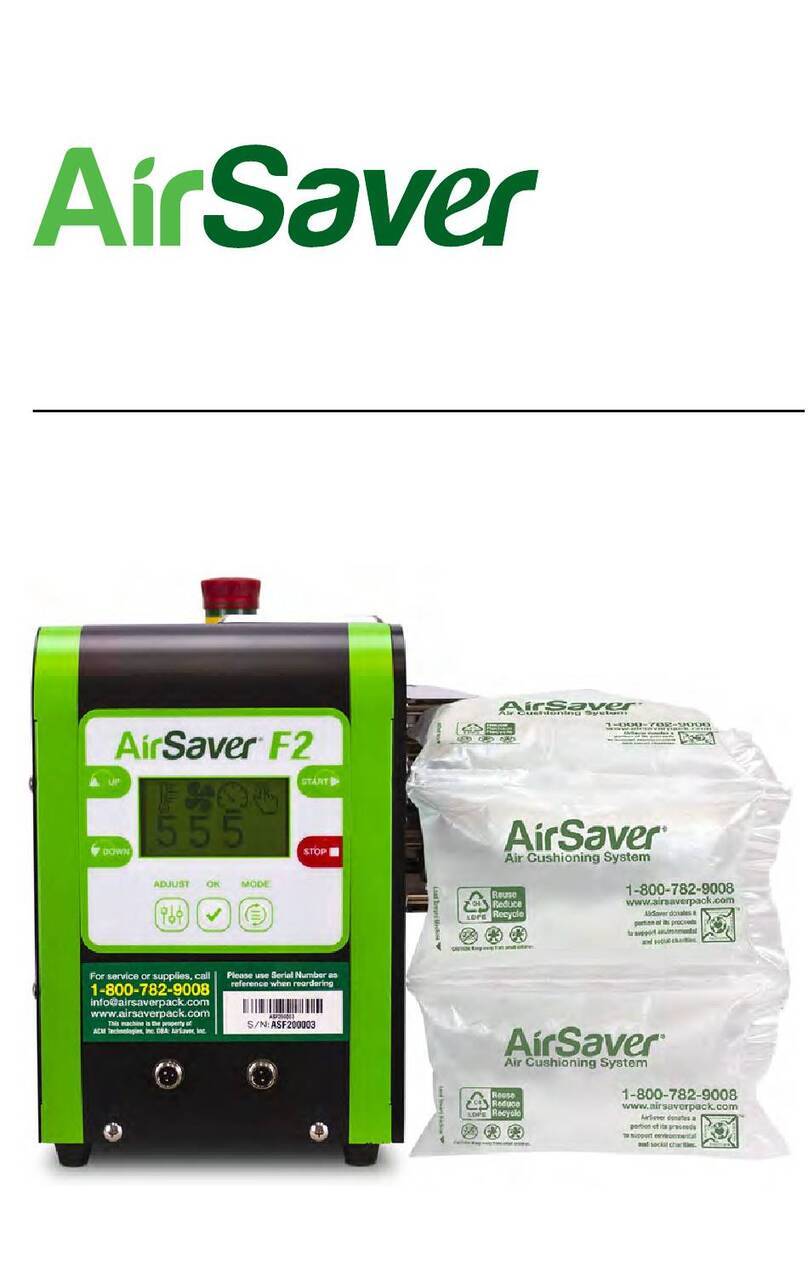
AirSaver
AirSaver F2 Safety instructions, setup & installation manual
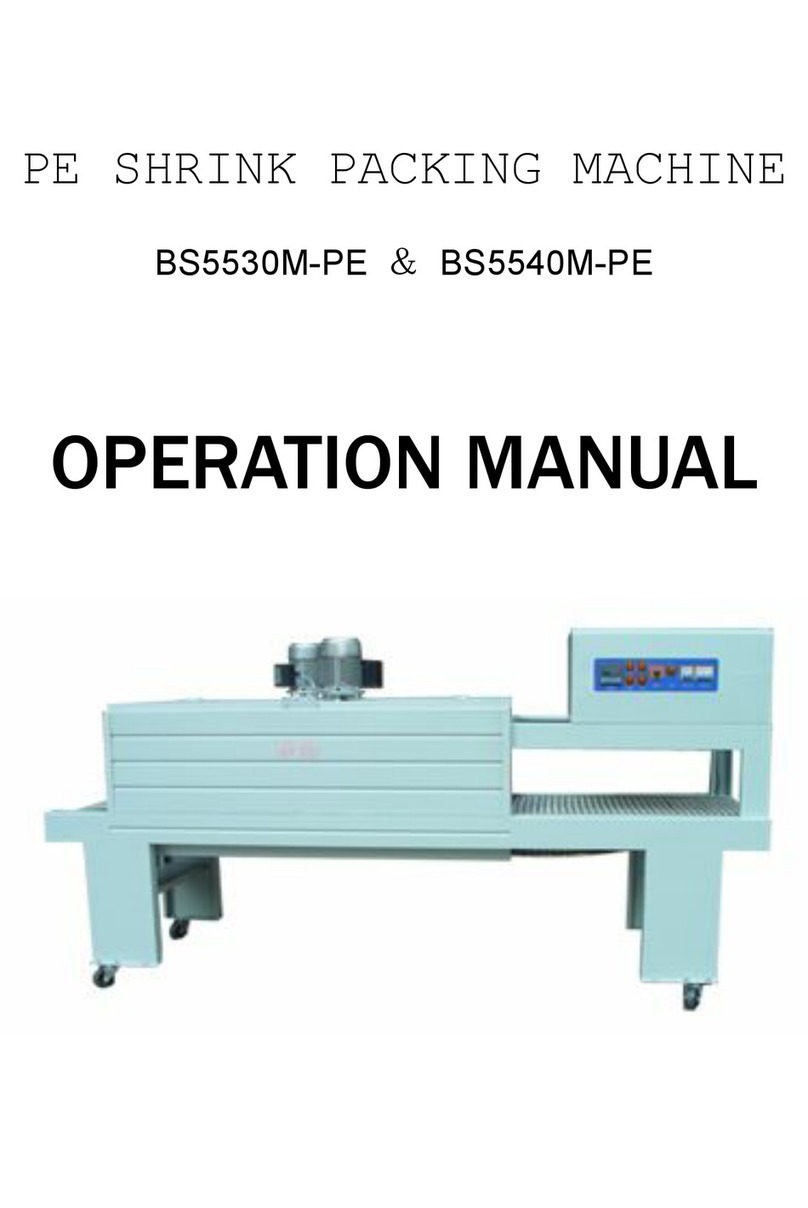
HUALIAN
HUALIAN M-PE Series Operation manual

Pro Pack Solutions
Pro Pack Solutions Eagle 710 Operation manual

Oliver
Oliver 1808-D User's operation

Kronos
Kronos H-46 Series Operation, safety and spare parts manual
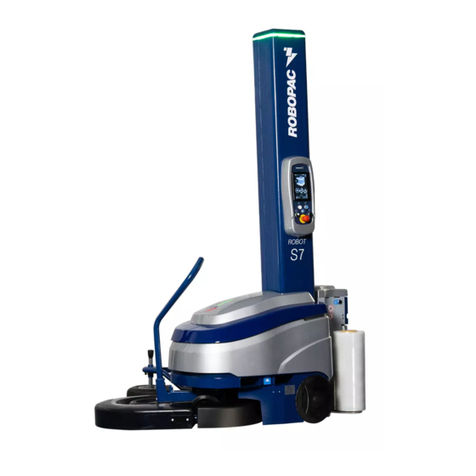
Robopac
Robopac ROBOT S7 Use and maintenance manual


